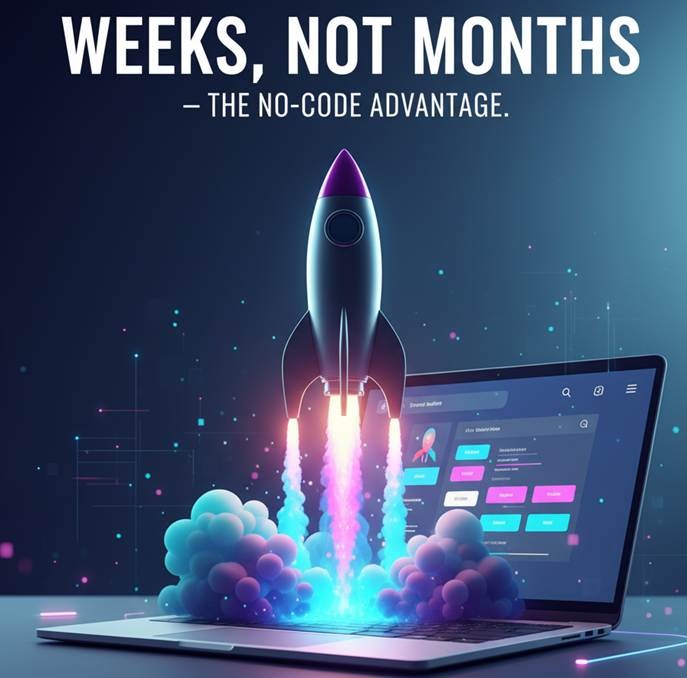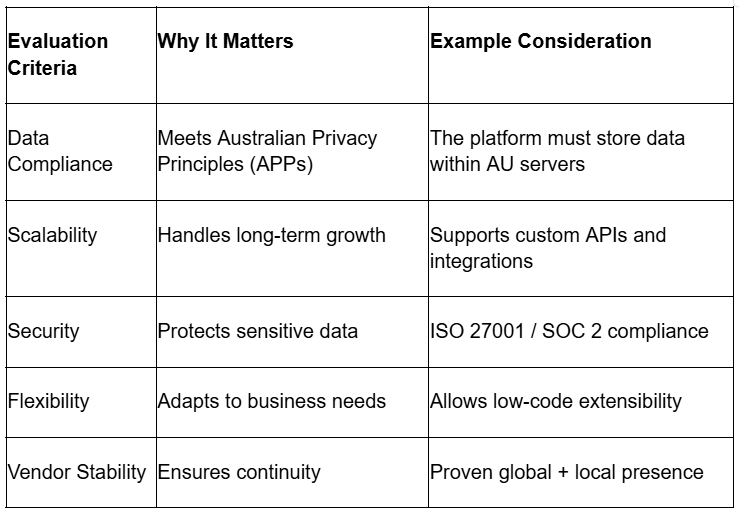1. Introduction: setting the context for Australia
The old model for developing enterprise-class applications that relied heavily on programming, lengthy development cycles, and the need for large teams of technical personnel has become unsustainable due to rapid changes in the digital landscape.
Australian companies, like those all over the world, face continuous challenges to be able to innovate at a faster rate while reducing their costs and delivering consistent, high-quality digital experiences to their customers.
A recent wave of software development has emerged to meet the need for companies to develop applications quickly—and at lower cost. No-code, low-code Tools enable developers, designers, and even non-technical people to create robust, scalable applications using intuitive, drag-and-drop graphical user interface (GUI) interfaces and integrated back-end services — all without writing significant code.
As a result of No-code, low-code Tools, the process of developing business applications has changed dramatically. The use of No-code, low-code Tools enables the rapid transition of ideas from the conceptual stage to a launched product within weeks rather than months; this allows teams to rapidly prototype, test, and deploy applications with unparalleled speed and efficiency. The No-code, low-code Tools also enable collaboration among technical and non-technical team members, which creates an environment that fosters innovation.

Visual Development Tools present a strategic opportunity for Australian startups, enterprises, and government organizations to remain competitive in the rapidly changing digital economy. By adopting these cutting-edge platforms, organizations will be able to increase the pace of digital transformation, alleviate talent shortages, and bring innovative products to market faster than at any time previously.
In this blog, we will examine the effects of No-code, low-code Tools in Australia, the benefits of their adoption, and how they are revolutionizing the application development industry across multiple sectors.
2. What is No-Code / Low-Code? Quick overview
No Code Development is a form of building an application via a visual interface (drag & drop) with pre-determined logic flow for the end user that does not require them to write traditional code.
Low-code development allows for some basic coding capabilities when the need to build advanced features/functions or integrate into existing systems occurs.
Both No Code & Low Code Platforms have changed how software applications can be built as they allow non-technical teams (analysts, designers, etc.) to create applications while still providing the ability for technical teams to collaborate and assist with the creation of more complex parts of the application.

The use of No Code & Low Code platforms has reduced bottlenecks within the development cycle; accelerated the development process; increased collaboration among departments; and ultimately allowed businesses to get products to market faster. The use of No Code & Low Code platforms has been especially valuable for businesses located in fast-evolving markets such as Australia, where speed of innovation and scalability of digital solutions are critical.
3. Australia’s Digital Landscape: Why No-Code Matters
A rapid digital transformation is underway in Australia due to changing customer demands, growth of new startup ecosystems, and a push for both automation and adoption of cloud-based services; however, a common issue remains—many organizations still struggle with the lack of skilled developers and the high costs associated with the use of traditional methods of development. The no-code and low-code solution offers an alternative in Australia’s digital landscape.

3.1. The State of Australia’s Digital Economy
The Australian digital Landscape economy will be estimated to generate in excess of AUD $250 billion per annum by 2030 (Deloitte Access Economics). Digital infrastructure, innovation funding, and citizen-first digital service are at the forefront of government policy at both the Federal and State levels. As rapid technological adoption creates an increasing need for qualified developers, it also generates an expanding skills gap between sectors.

3.2. SMEs and Startups: The Heart of Innovation
There are over 2.5 million small and medium-sized business enterprises (SME) in Australia, with many SMEs being run on tight budgets and having few IT employees. Therefore, no code-based development platforms offer an affordable route to digital transformation for many Australian SMEs. They can now use no-code platforms to build automated processes, create customer portal sites, and develop prototypes for mobile applications, etc., rather than needing to hire entire full-time development teams.
3.3. Government and Enterprise Adoption
No-code, low-code tools are being adopted by Government Departments and Enterprises in Australia as well, in order to develop modernized, legacy system applications to provide citizen-centric services faster. No-code, low-code tools are also being utilized to deploy citizen-facing applications such as Digital Identity Systems, Local Council Apps, and others in a much faster manner than traditional methodologies, while making them more accessible to citizens across all demographics and enhancing compliance with local Data Sovereignty Laws.
3.4. A Perfect Fit for the Australian Market
Australia presents a unique combination of innovative small to medium-sized enterprise (SME) companies, regional skill shortages, and significant Public Sector digital transformation that will enable no-code, low-code technologies to be adopted in greater numbers and faster than other countries. These platforms offer speed, reduced cost, flexibility, and inclusion, which are all attributes that make them not just a technical advantage but a key strategic requirement to advance Australia's digital future.
4. Key Impacts of No-Code Development in Australia
No-code, low-code development tools are changing how many Australian organizations develop, test, and deploy their software. The technology is providing a catalyst for all three types (start-ups, large enterprises, and Government Agencies) to move at speed through their digital transformations. The No-code platform will have an increasing impact in the following ways.
4.1. Accelerated Time-to-Market
No-code, low-code development tools are changing how many Australian organizations develop, test, and deploy their software. The technology is providing a catalyst for all three types (start-ups, large enterprises, and Government Agencies) to move at speed through their digital transformations. The No-code platform will have an increasing impact in the following ways.

4.2. Cost Efficiency
As a result of requiring fewer full-stack developers and having less ongoing overhead costs, the overall total cost of ownership is greatly reduced. Regional and mid-sized Australian businesses benefit from these efficiencies, allowing them to invest in their digital transformation without breaking the bank, thus leveling the playing field with larger competitors.
4.3. Democratisation of Development / Citizen-Developers
The ability of no-code platforms is to allow all employees that are not in the IT department (i.e., business analysts, product managers, and operational leads) to be able to develop software themselves. The democratization of development expands the talent pool of people who can create innovative solutions to problems, which also provides a more open and accessible way for Australians, especially those working remotely, to participate digitally in their workplaces.
4.4. Support for SMEs and Startups
Small and Medium-sized Enterprises (SMEs) make up the majority of the economy in Australia. The use of no-code tools allows SMEs to develop, test, and expand their digital offerings rapidly with less reliance on large technology teams, which will encourage SMEs to experiment and take risks to validate their new ideas in markets much quicker than they have in the past.
4.5. Enterprise Adoption & Digital Transformation
A growing number of major Australian companies and government agencies are implementing no-code and visual development tools to modernize their internal processes, automate internal business workflows, and provide better services to citizens using their public services. Reducing the dependence on older systems enables the large-scale and agile digital transformations of major organizations.
4.6. Skills Shortage Alleviation
No-code, low-code development tools address one of the most pressing issues in Australian software engineering – a chronic skills shortage in this area (especially outside of major metropolitan areas) by allowing businesses to be less reliant on specialist skill sets, thereby assisting them to address recruitment difficulties and speed up project delivery using fewer people on their technical team.
4.7. Innovation in sectors: Government, FinTech, EdTech, Health
No-code development enables innovation in sectors such as:
• Public sector & Government: faster deployment of digital services for citizens and other regional initiatives.
• Fintech: rapid prototype (MVP) creation, compliance process improvements, and better customer-facing Apps.
• Education Technology (EdTech) and Health Care: launch of e-learning platforms, patient engagement tools, and telehealth solutions without having to build from scratch.
This is how no-code development is helping Australia to transition to an agile and innovative, digitally inclusive economy where more ideas can now develop into practical reality faster than has previously been possible.

5. Challenges & Considerations in the Australian Context
As organizations accelerate their digital transformation journey in Australia, it will be critical for them to balance speed and ease-of-use with governance, scalability, and compliance, as the opportunities presented by the use of No-Code and Low-Code Development are truly revolutionary.
5.1. Governance compliance, data sovereignty
With some of the world's most stringent data protection and privacy laws, including the Australian Privacy Principles (APPs), and strict data sovereignty regulations, any organization using No-Code and Low-Code Platforms to manage sensitive user or financial data must ensure that their data storage and processing occurs within an Australian-based data center. Organizations must verify compliance with relevant international standards such as ISO 27001, SOC 2, etc., before onboarding.
5.2. Scalability and Performance Limitations
While No-Code Platforms are ideal for rapid application development, there may be limitations in terms of scalability if an application grows in complexity or user volume. Large-scale enterprise applications require an assessment of whether the chosen tool supports API integration, advanced logic, and performance optimization. In addition to considering the speed at which an application can be developed, consideration must also be given to the long-term flexibility and architectural control provided by the selected tool.
5.3. Risk of Vendor Lock-In
Some No-Code and Low-Code Platforms limit customization or create barriers to migrating to traditional environments. These restrictions on customization can hinder innovation and create long-term costs for Australian Businesses. Organizations should select solutions that utilize open standards, support exporting code, or support a Hybrid No-Code/Low-Code Architecture to avoid vendor lock-in.
5.4. Skill Shift and Organisational Culture
More than just a technological transition, adopting a No-Code environment requires a cultural mind-shift for Developers, Designers, and Business Users who must work together differently to achieve common goals. Creating a Centre of Excellence (CoE) or establishing a governance framework internally ensures consistency, security, and best practices are followed by Citizen Developers as they grow in numbers. Providing training programs and creating a formal onboarding process will help to facilitate adoption while maintaining the level of quality required.
5.5. Integration with Legacy Systems
Many Australian organizations continue to utilize legacy infrastructure, such as ERP systems, on-prem databases, or older Government Software. The integration of these legacy systems with No-Code Platforms can be difficult. Selecting a No-Code Platform that provides robust REST APIs, Web Hooks, and Third Party Connectors will greatly simplify bridging the gap to legacy systems.
5.6. Cost vs. Long-Term ROI
While initial costs associated with No-Code, Low-Code Development are minimal, organizations must also account for subscription fees related to the platform, additional features, and scaling costs. Organizations should establish a clear Return on Investment (ROI) methodology, i.e., Time Saved, Operational Efficiency, Reduced Technical Backlog, etc., to ensure that long-term viability exists.
In conclusion, the No-Code, low-code Development Opportunity in Australia is enormous; however, achieving success in this emerging landscape requires careful planning, effective governance, and strategic partnerships. By finding a balance between the need for speed and compliance, Australian Organizations will have the ability to leverage these tools to create a more connected, efficient, and innovative Digital Future.
6. Best Practices for Australian Businesses Adopting No-Code
Deciding to adopt a No-Code and/or Low-Code solution is as much about the future of your business (strategy) as it is about technology. The shift to No-Code and/or Low-Code will be one that has a major impact on the way you innovate, collaborate, and ultimately deliver value for your customers, clients, stakeholders, and employees. In Australia, where both Agility and Compliance are paramount, ensuring a successful No-Code/Low-Code solution implementation is essential in order to ensure a scalable and sustainable future.
6.1. Define a Clear Digital Strategy
Prior to investing in a No-Code Platform, your organisation needs to determine what your digital transformation objectives are. Are they to create efficiencies by automating workflows? Create mobile applications for your customers? Improve operational efficiency through internal solutions? Ensuring that the adoption of the No-Code Platform(s) supports the strategic plan of your business will provide quantifiable results.
6.2. Select the Right Platform
Choosing the right platform is crucial. Australian businesses must consider factors such as:
- Data sovereignty — Ensure hosting within Australian or compliant data centres.
- Scalability — Assess support for API integrations, custom logic, and user growth.
- Security certifications — Look for ISO 27001, SOC 2, or IRAP-compliant platforms.
- Ecosystem and support — Choose vendors with active developer communities and local or regional support teams.

6.3. Establish Governance and Oversight
Lack of governance over decentralized apps, which are being developed by their users, could be inefficient or unsafe. Establishing a Center of Excellence (CoE), which defines standard code practices, version control practices, who has access to applications, security policies, etc., will help facilitate collaboration among IT and Business departments, while still maintaining the appropriate level of oversight.
6.4. Start Small, Scale Gradually
Using a "Pilot" type of project, such as building an internal dashboard or automating an existing internal workflow, will allow you to test the platform's capabilities and track your successes, such as how much time was saved developing the application, how many users adopted the application, and if there were any cost savings. Once you have proven the platform's value, you can expand to company-wide projects.
6.5. Upskill and Empower Teams
Provide ongoing training opportunities using platform-specific training sessions, certifications, and workshops to continue to empower your employees to develop and innovate within the confines of your organization. This will ultimately reduce your dependence on third-party vendors and establish a sustainable innovation culture.
6.6. Measure ROI and Iterate
Establish Key Performance Indicators (KPIs) such as Development Cycle Time, Error Reduction, Customer Satisfaction, etc. Continuously monitor and adjust your process to align with organizational goals.
In conclusion, to successfully implement no-code development in Australia, organizations must strike a balance between strategy, governance, and employee education. With careful planning and execution, organizations can accelerate innovation, foster collaboration, reduce costs, and position themselves for long-term success in today's rapidly changing digital world.
7. Future Outlook: Australia in 2025-2030
Between 2025–2030, Australia's Digital Economy will undergo a significant shift as No-Code and Low-Code Platforms transition from being niche enablement tools to mainstream acceleration engines for Australian Innovators.

7.1. A Digitally Inclusive Innovation Wave
In 2030, it is estimated that more than 60% of all new digital solutions in Australia will be either developed or supported by No-Code or Low-Code Environments. This will further help democratize innovation and allow entrepreneurs, educators, and Small and Medium Enterprises (SMEs), especially in rural/remote areas, to engage in the Digital Economy, regardless of their level of technical expertise. As a result, this will create an innovative ecosystem where ideas are driving impact faster than coding.
7.2. AI-Enhanced Development Becomes the Norm
AI will seamlessly merge into Visual Development Tools to provide auto-suggested workflows, natural language to app creation, and predictive analytics for businesses to develop their products faster, reduce costs, and increase efficiency. Businesses will increasingly use AI Copilots to speed up the development of products, automate compliance testing, and even improve user experience in real time.

7.3. The Workforce Transformation
As we move forward in time, Australia's workforce will begin to focus on hybrid-digital roles — where designers, data analysts, and domain experts all work together through visual development environments; this means that the current divisions between "IT" and "the business" will become obsolete. This will be possible because Citizen Developers 2.0 will develop production-level applications with little or no coding required.
The education sector will have an enormous role in the future of no-code, low-code, and AI-assisted visual development and will be responsible for educating the next generation of developers by making no-code and automation part of the curriculum in both STEM and Business programs. Universities and TAFES are expected to form partnerships with technology companies to provide students with hands-on experience in platforms such as FlutterFlow, Buildship, and Airtable.
7.4. Government and Sustainability
By providing funding and developing policies and programs for skill development (Digital Economy Strategy 2030), government agencies will drive the adoption of no-code technologies. Additionally, with sustainable practices becoming a national priority, governments and organizations will utilize no-code platforms to build more efficient, cost-effective, green digital solutions with minimal waste and optimal use of resources.
Overall, by 2030, no-code, low-code, and AI-assisted visual development will revolutionize how innovations happen, enabling them to occur faster, smarter, and more inclusive to everyone. The world of the future belongs to those who can think boldly and build visually.
8. Conclusion
The digital revolution led by no-code, low-code & AI-assisted visual development tools in Australia is at its peak. With these developments combining innovation, accessibility, and rapidity together, there has never been a better time to create an idea, develop it into a working prototype, and launch it to market than today. The government and many start-ups are developing new ways to provide citizen services and disrupt old markets. The way that technology is being developed and deployed is changing dramatically.
While the ecosystem continues to mature, success will depend not only on selecting the correct platform for your business but also on developing the right expertise and strategy to use those platforms correctly. It is here that FlutterflowDevs can assist you.
At FlutterflowDevs, we provide all Australian Businesses access to the full capabilities of no-code and low-code application development — assisting with the transition from creative ideas to successful and scalable solutions. With our certified teams of FlutterFlow, BuildShip, and Rowy.io experts, we develop scalable, secure, and high-performance solutions for the FinTech, EdTech, HealthTech, AI, and SaaS sectors. We work with early-stage MVPs through large-scale enterprise-grade Digital Solutions, to ensure every one of our clients' products delivers Impact, Scalability, and Growth.
In addition to providing Development Services, we act as Digital Innovation Enablers for our clients — providing strategic direction on Architecture, Integration, Compliance, and Deployment. By taking a holistic view of our clients' digital needs, we enable our clients to focus on what is important — Solving Real-World Problems and Creating Value.
The future of Digital Creation in Australia is not about writing more code — it is about giving more people the ability to build, test, measure, and innovate using Visual Development tools. Low-Code and No-Code Platforms will continue to empower a new generation of Makers — Disrupting Every Industry in Australia.
We are proud to be involved in this Journey, helping Australia Build Its Future Visually at FlutterflowDevs.










.png)
.png)


.png)

.png)
.png)

